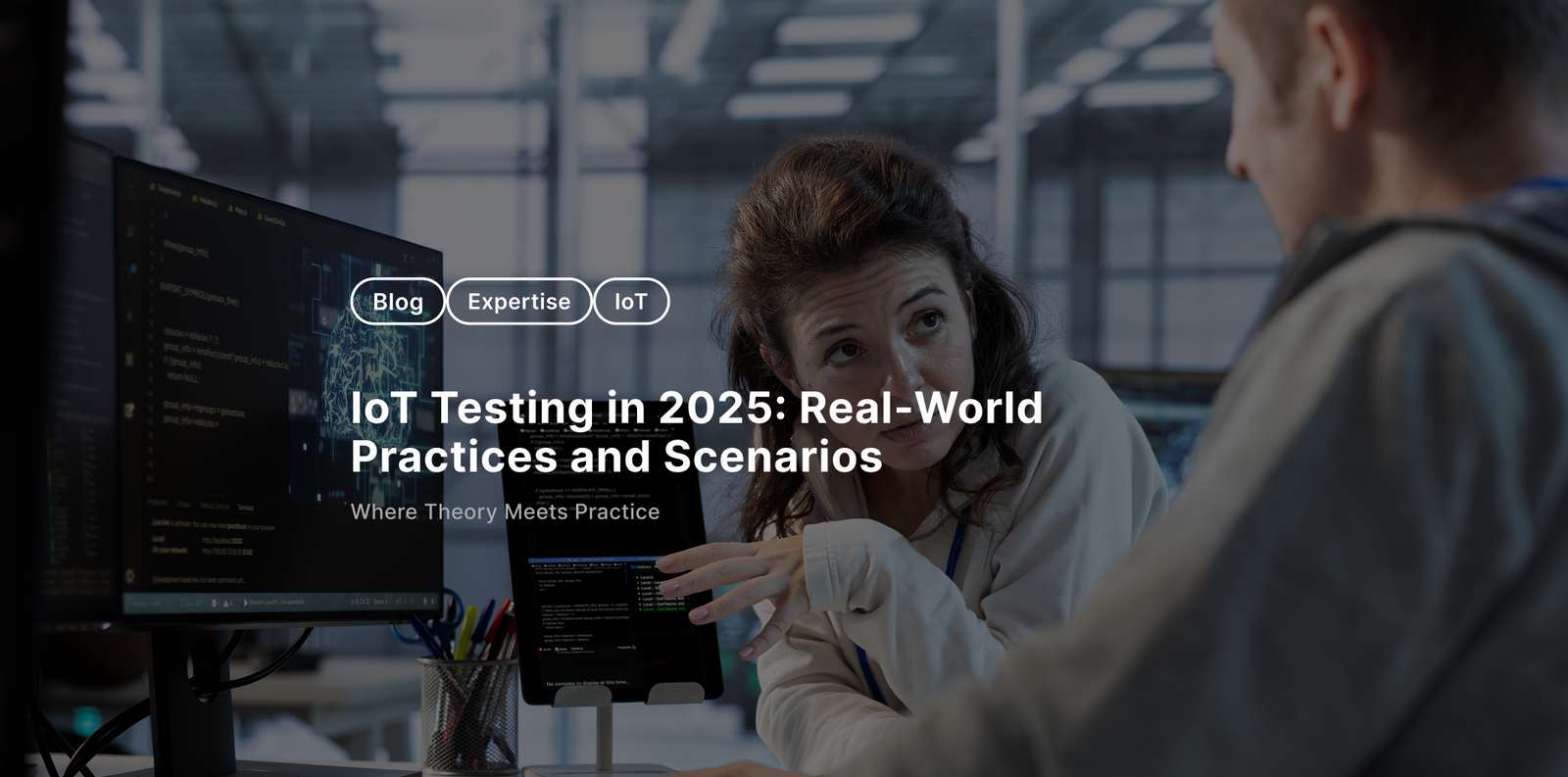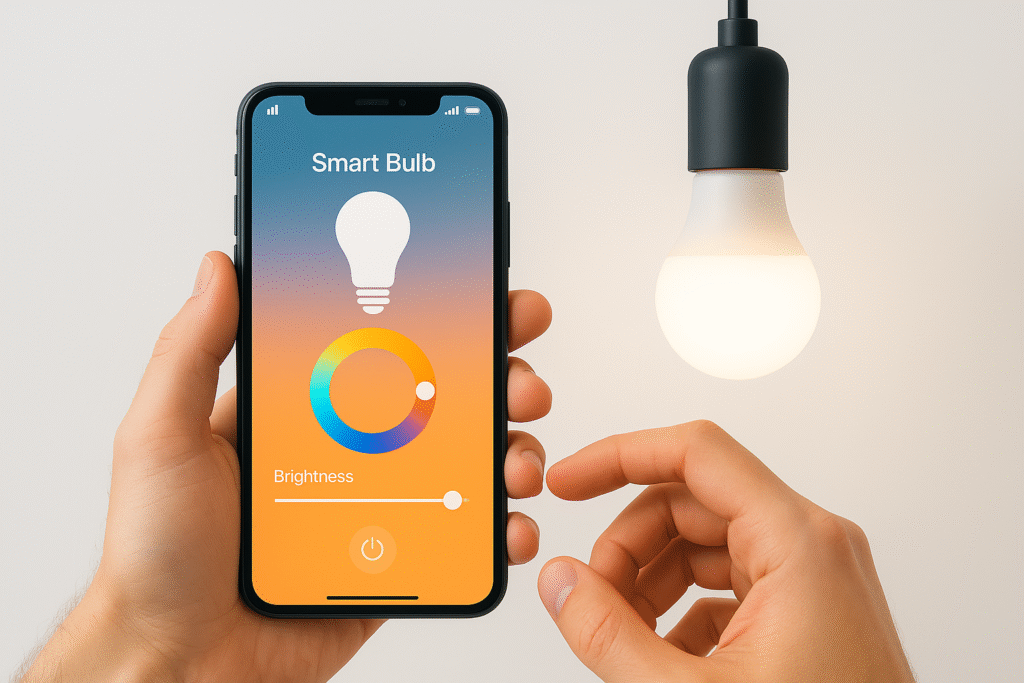✆ + 1-646-235-9076 ⏱ Mon - Fri: 24h/day
IoT Testing in 2025: Real-World Practices and Scenarios


As the Internet of Things (IoT) continues to reshape modern life in 2025, software testers are at the forefront of a rapidly changing technological landscape. Devices are becoming smarter, more autonomous, and deeply integrated with cloud services and voice platforms like Alexa and Google Assistant. Expectations for reliability, security, and user experience have never been higher.
IoT testing is no longer just about checking isolated features. It now involves validating how hardware, software, networks, and third-party services work together as a single, cohesive system. In this connected world, the role of QA in IoT development is more important than ever. It requires technical expertise, adaptability, critical thinking, and a strong understanding of how technology fits into daily life.
What IoT Means for Testers
An IoT system usually consists of several interconnected components. These include the physical device (such as a smart light bulb, camera, plug, or LED strip), embedded firmware that controls its core functions, and a mobile or web application for user interaction. It also depends on cloud infrastructure for data storage and remote connectivity, along with integration to third-party services like voice assistants (e.g., Amazon Alexa or Google Assistant).
For testers, this creates a complex challenge. Unlike traditional software systems, IoT testing must validate each component and confirm they work together as a reliable, unified system. This involves checking that commands from a mobile app or voice assistant are interpreted correctly, sent through the cloud, and executed by the device with minimal delay and no loss of functionality.
Testing must also reflect real-world conditions. Unstable networks, interoperability issues, hardware limitations, and varied user behaviors can all affect performance. Testers need to simulate scenarios such as network disconnections, multiple users controlling the device at once, or switching between local and remote control.
Ultimately, IoT testing is about more than verifying functions. It ensures a seamless, secure, and user-friendly experience in a complex, distributed environment. Achieving this requires a combination of traditional testing methods, real-device testing, cloud-based validation, and a deep understanding of how hardware and software interact.
Key Types of IoT Testing
1. Functional Testing
Ensures the core features of the device work properly. For example, does the light bulb turn on via the app? Does the camera stream video to the cloud?
2. Compatibility Testing
Extremely relevant in 2025, as many users rely on voice assistants. Testing involves verifying that devices work smoothly with Alexa and Google Assistant, respecting each assistant’s unique integration protocols.
3. Connectivity Testing
Simulates unstable or interrupted Wi-Fi to observe device behavior. Will it reconnect automatically? What happens after a router reboot?
4. Security Testing
With data privacy and cybersecurity in the spotlight, testers must check encryption, secure authentication, and block unauthorized network access.
5. Firmware Update Testing
Devices often update automatically. It’s essential to test whether updates install properly without affecting user preferences or causing downtime.
6. Localization and Regional Testing
As IoT devices are sold globally, it’s crucial to ensure they function correctly across different regions. This type of testing verifies that language translations are accurate, UI elements are properly adapted for different locales, and region-specific settings such as time zones, measurement units, voltage standards, and regulations are respected.
7. Usability Testing (UX Testing)
Beyond technical performance, a device must provide a smooth and intuitive user experience. Usability testing should focus on how real users interact with the application or device – from setup and pairing to daily use. Are the onboarding steps clear? Can users easily connect the device to Wi-Fi or voice assistants? Is the mobile interface intuitive and easy to navigate?
Even if the device works as expected, a confusing or frustrating user experience can lead people to stop using it.
Practical Testing Scenarios
Smart Light Bulb
Testing a smart light bulb goes beyond simply checking if it turns on and off. It requires a full evaluation of all its features. This includes verifying the stability of its Wi-Fi or Bluetooth connection, ensuring the mobile app controls it correctly, and confirming it interacts smoothly with other IoT devices, such as voice assistants like Google Assistant or Alexa.
Testers also need to measure response times, check the accuracy of brightness and color changes, and observe behavior during network outages. Firmware updates must be tested to ensure they install without issues, and data transmission should be secure. Equally important are scenarios that involve multiple users or scheduled control, which can reveal performance and reliability gaps.


Source: Image generated by AI
Typical test cases include:
- Device pairing and registration via mobile app: The tester checks whether the bulb connects easily to the application via Wi-Fi or Bluetooth. Multiple attempts and edge cases such as incorrect passwords or delayed responses are tested.
- Voice control detection by Alexa or Google Assistant: After linking the device to a voice assistant platform, testers verify whether the assistant detects the bulb promptly and accurately.
- Execution of commands like “Alexa, turn on the bedroom light”: Commands are tested for responsiveness, execution time, and reliability. Additional testing includes phrases with different wording or accents.
- Voice-controlled dimming and color changes: Testers evaluate whether brightness levels and RGB color changes happen smoothly, including how well the voice assistant interprets partial or ambiguous commands.
- Response during network interruptions: By temporarily disabling internet or Wi-Fi, testers observe how the bulb behaves when offline. Reconnection time and restoration of previous settings after reconnection are key metrics.
Smart Security Camera
Testing smart security cameras focuses on video quality, alerts, and integration. Key scenarios include:
- Streaming quality in online/offline modes: Testers check the quality of video streaming to make sure it works correctly — without interruptions, delays, or drops in resolution, even when the internet connection is not perfect.
- Alexa integration for live view on Echo Show or similar devices: The test ensures that the camera feed can be requested and displayed via voice on compatible smart screens, checking for delays and resolution fidelity.
- Motion detection accuracy and alert delays: The tester simulates motion events and measures how quickly and accurately the camera sends notifications to the user. False positives or missed events are noted.
- Night mode performance and sensor calibration: Using controlled lighting conditions, testers verify the effectiveness of infrared or low-light modes. They also check if the camera automatically adjusts based on ambient lighting and how well motion detection functions in the dark.
Fordewind Team’s Testing of Geeni Smart Home Solutions


As part of our collaboration with MyGeeni, our team tests smart home products to ensure they meet the highest standards of quality, stability, and ease of use. MyGeeni offers an innovative ecosystem of devices, including smart bulbs, plugs, security cameras, motion sensors, and more.
Our mission is to give every Geeni user a reliable, secure, and intuitive smart home experience, no matter their technical background. Through hands-on testing, we identify potential issues early and provide feedback that helps shape products to better fit everyday needs.
To learn more about this project and our ongoing work with MyGeeni, explore this section for insights into our real-world testing approach. Here, you can see how we test, discover real-life use cases, and learn how our collaboration helps create smarter, more user-friendly homes.
Conclusion
IoT testing in 2025 goes far beyond pressing buttons and ticking boxes. It’s about understanding the entire ecosystem – how the device works with voice assistants, how stable its connections are, and how securely it handles data. Testers serve as a vital link between complex technology and real human needs, ensuring products remain reliable in an increasingly connected world.
As demand for smart home and IoT solutions grows, so does the need for testing that is thorough, user-focused, and security-driven. These practices must keep pace with rapid innovation to deliver safe and seamless experiences.